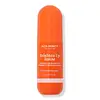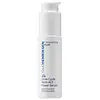What's inside
What's inside
 Key Ingredients
Key Ingredients

 Benefits
Benefits

 Concerns
Concerns

 Ingredients Side-by-side
Ingredients Side-by-side

Water
Skin ConditioningDimethicone
EmollientPropanediol
SolventGlycerin
HumectantGlycolic Acid
BufferingPolysilicone-11
Tetrahexyldecyl Ascorbate
AntioxidantPhenoxyethanol
PreservativeHydroxyethyl Acrylate/Sodium Acryloyldimethyl Taurate Copolymer
Emulsion StabilisingSodium Hydroxide
BufferingXanthan Gum
EmulsifyingButylene Glycol
HumectantAllantoin
Skin ConditioningPolyacrylate Crosspolymer-6
Emulsion StabilisingEthylhexylglycerin
Skin ConditioningSorbitan Isostearate
EmulsifyingTetrasodium Glutamate Diacetate
Decyl Glucoside
CleansingCaprylyl Glycol
EmollientHexylene Glycol
EmulsifyingT-Butyl Alcohol
PerfumingLactobacillus Ferment Lysate
Skin ConditioningTin Oxide
AbrasiveLaminaria Digitata Extract
Skin ProtectingSpirulina Platensis Extract
Skin ProtectingUlva Lactuca Extract
Skin ConditioningPhytic Acid
Mica
Cosmetic ColorantCI 77891
Cosmetic ColorantIron Oxides
Water, Dimethicone, Propanediol, Glycerin, Glycolic Acid, Polysilicone-11, Tetrahexyldecyl Ascorbate, Phenoxyethanol, Hydroxyethyl Acrylate/Sodium Acryloyldimethyl Taurate Copolymer, Sodium Hydroxide, Xanthan Gum, Butylene Glycol, Allantoin, Polyacrylate Crosspolymer-6, Ethylhexylglycerin, Sorbitan Isostearate, Tetrasodium Glutamate Diacetate, Decyl Glucoside, Caprylyl Glycol, Hexylene Glycol, T-Butyl Alcohol, Lactobacillus Ferment Lysate, Tin Oxide, Laminaria Digitata Extract, Spirulina Platensis Extract, Ulva Lactuca Extract, Phytic Acid, Mica, CI 77891, Iron Oxides
Water
Skin ConditioningPropanediol
SolventGlycerin
HumectantSqualane
EmollientGlycereth-26
HumectantGlyceryl Polyacrylate
Mica
Cosmetic ColorantCetearyl Alcohol
EmollientBakuchiol
AntimicrobialPolyacrylate Crosspolymer-6
Emulsion StabilisingDimethicone
EmollientPolyglyceryl-10 Laurate
Skin ConditioningAminomethyl Propanol
BufferingHydrolyzed Jojoba Esters
Skin ConditioningPhenoxyethanol
PreservativeHydroxyacetophenone
AntioxidantParfum
MaskingCeteareth-20
CleansingGlycolic Acid
BufferingLactic Acid
BufferingLeontopodium Alpinum Callus Culture Extract
AntioxidantCaesalpinia Spinosa Fruit Extract
Skin ProtectingCellulose Gum
Emulsion StabilisingHibiscus Sabdariffa Flower Extract
Skin ConditioningKappaphycus Alvarezii Extract
Skin ConditioningSilica
AbrasiveGlycyrrhiza Glabra Root Extract
BleachingCitrus Limon Fruit Extract
MaskingSaccharum Officinarum Extract
MoisturisingChamomilla Recutita Flower Extract
MaskingSantalum Album Extract
CleansingTrisodium Ethylenediamine Disuccinate
Leuconostoc/Radish Root Ferment Filtrate
AntimicrobialXanthan Gum
EmulsifyingEthylhexylglycerin
Skin ConditioningCitric Acid
BufferingLimonene
PerfumingLinalool
PerfumingCitral
PerfumingCI 77891
Cosmetic ColorantCI 60730
Cosmetic ColorantCI 14700
Cosmetic ColorantWater, Propanediol, Glycerin, Squalane, Glycereth-26, Glyceryl Polyacrylate, Mica, Cetearyl Alcohol, Bakuchiol, Polyacrylate Crosspolymer-6, Dimethicone, Polyglyceryl-10 Laurate, Aminomethyl Propanol, Hydrolyzed Jojoba Esters, Phenoxyethanol, Hydroxyacetophenone, Parfum, Ceteareth-20, Glycolic Acid, Lactic Acid, Leontopodium Alpinum Callus Culture Extract, Caesalpinia Spinosa Fruit Extract, Cellulose Gum, Hibiscus Sabdariffa Flower Extract, Kappaphycus Alvarezii Extract, Silica, Glycyrrhiza Glabra Root Extract, Citrus Limon Fruit Extract, Saccharum Officinarum Extract, Chamomilla Recutita Flower Extract, Santalum Album Extract, Trisodium Ethylenediamine Disuccinate, Leuconostoc/Radish Root Ferment Filtrate, Xanthan Gum, Ethylhexylglycerin, Citric Acid, Limonene, Linalool, Citral, CI 77891, CI 60730, CI 14700
Ingredients Explained
These ingredients are found in both products.
Ingredients higher up in an ingredient list are typically present in a larger amount.
Ci 77891 is a white pigment from Titanium dioxide. It is naturally found in minerals such as rutile and ilmenite.
It's main function is to add a white color to cosmetics. It can also be mixed with other colors to create different shades.
Ci 77891 is commonly found in sunscreens due to its ability to block UV rays.
Learn more about CI 77891Dimethicone is a type of synthetic silicone created from natural materials such as quartz.
What it does:
Dimethicone comes in different viscosities:
Depending on the viscosity, dimethicone has different properties.
Ingredients lists don't always show which type is used, so we recommend reaching out to the brand if you have questions about the viscosity.
This ingredient is unlikely to cause irritation because it does not get absorbed into skin. However, people with silicone allergies should be careful about using this ingredient.
Note: Dimethicone may contribute to pilling. This is because it is not oil or water soluble, so pilling may occur when layered with products. When mixed with heavy oils in a formula, the outcome is also quite greasy.
Learn more about DimethiconeEthylhexylglycerin (we can't pronounce this either) is commonly used as a preservative and skin softener. It is derived from glyceryl.
You might see Ethylhexylglycerin often paired with other preservatives such as phenoxyethanol. Ethylhexylglycerin has been found to increase the effectiveness of these other preservatives.
Glycerin is already naturally found in your skin. It helps moisturize and protect your skin.
A study from 2016 found glycerin to be more effective as a humectant than AHAs and hyaluronic acid.
As a humectant, it helps the skin stay hydrated by pulling moisture to your skin. The low molecular weight of glycerin allows it to pull moisture into the deeper layers of your skin.
Hydrated skin improves your skin barrier; Your skin barrier helps protect against irritants and bacteria.
Glycerin has also been found to have antimicrobial and antiviral properties. Due to these properties, glycerin is often used in wound and burn treatments.
In cosmetics, glycerin is usually derived from plants such as soybean or palm. However, it can also be sourced from animals, such as tallow or animal fat.
This ingredient is organic, colorless, odorless, and non-toxic.
Glycerin is the name for this ingredient in American English. British English uses Glycerol/Glycerine.
Learn more about GlycerinGlycolic Acid is arguably the most famous alpha hydroxy acid (AHA) with tons of research backing its benefits.
It is found naturally in sugar cane but the form used in skincare is usually synthetic for purity and stability.
Glycolic acid removes the top layer of dead skin cells to allow newer and fresher ones to emerge.
AHAs work by breaking down the structural “glue” that holds old skin cells in place. When that buildup is gone, your skin can renew itself more efficiently.
Research also shows glycolic acid stimulates collagen production, helping to firm and thicken the skin over time. This is one of its biggest advantages over other AHAs.
Overall, glycolic acid helps with:
Fun fact: Glycolic acid boosts skin hydration by helping it produce molecules that increase hyaluronic acid naturally.
To work best, glycolic acid products should have a pH between 3-4 (that’s where exfoliation is most effective but still gentle on skin).
The pH and concentration of a product are key to its effectiveness:
It is normal to feel a slight stinging sensation when using glycolic acid. This usually fades as your skin adjusts.
Because glycolic acid has the smallest molecular size in the AHA family, it can penetrate deeper, which enhances its effectiveness but also makes it more likely to irritate sensitive skin.
If your skin is very sensitive or prone to rosacea, glycolic acid may be too strong; in that case, try milder options like lactic acid or a PHA instead.
Recent studies suggest glycolic acid might even help protect against UV damage. But don’t skip sunscreen! Freshly exfoliated skin is more sensitive to the sun.
Glycolic acid is a skincare superstar. It smooths, brightens, hydrates, and firms the skin. Unless you’re highly sensitive, it’s well worth adding to your routine.
Read more about some other popular AHA's here:
Learn more about Glycolic AcidMica is a naturally occurring mineral used to add shimmer and color in cosmetics. It can also help improve the texture of a product or give it an opaque, white/silver color.
Serecite is the name for very fine but ragged grains of mica.
This ingredient is often coated with metal oxides like titanium dioxide. Trace amounts of heavy metals may be found in mica, but these metals are not harmful in our personal products.
Mica has been used since prehistoric times throughout the world. Ancient Egyptian, Indian, Greek, Roman, Aztec, and Chinese civilizations have used mica.
Learn more about MicaPhenoxyethanol is a preservative that has germicide, antimicrobial, and aromatic properties. Studies show that phenoxyethanol can prevent microbial growth. By itself, it has a scent that is similar to that of a rose.
It's often used in formulations along with Caprylyl Glycol to preserve the shelf life of products.
Polyacrylate Crosspolymer-6 is a texture enhancer and pH adjuster.
It is be used to thicken water-based products and create a gel-texture with a velvet feel.
One manufacturer claims this ingredient to have a pH range of 2-8 and to be biodegradable.
Learn more about Polyacrylate Crosspolymer-6Propanediol is an all-star ingredient. It softens, hydrates, and smooths the skin.
It’s often used to:
Propanediol is not likely to cause sensitivity and considered safe to use. It is derived from corn or petroleum with a clear color and no scent.
Learn more about PropanediolWater. It's the most common cosmetic ingredient of all. You'll usually see it at the top of ingredient lists, meaning that it makes up the largest part of the product.
So why is it so popular? Water most often acts as a solvent - this means that it helps dissolve other ingredients into the formulation.
You'll also recognize water as that liquid we all need to stay alive. If you see this, drink a glass of water. Stay hydrated!
Learn more about WaterXanthan gum is used as a stabilizer and thickener within cosmetic products. It helps give products a sticky, thick feeling - preventing them from being too runny.
On the technical side of things, xanthan gum is a polysaccharide - a combination consisting of multiple sugar molecules bonded together.
Xanthan gum is a pretty common and great ingredient. It is a natural, non-toxic, non-irritating ingredient that is also commonly used in food products.
Learn more about Xanthan Gum